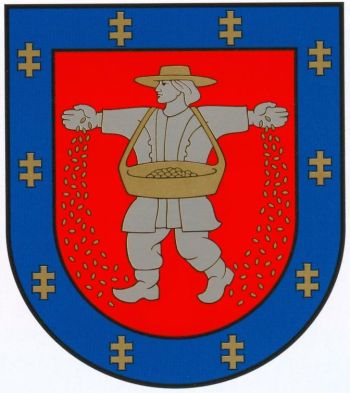Marijampolė (county)
| Heraldry of the World Civic heraldry of Lithuania - Lietuvas Heraldika |
MARIJAMPOLĖ COUNTY
Origin/meaning
The arms were granted on July 26, 2004.
The early origin of Marijampolė county is the Starapole district (Bezirk), established by the Prussia in 1795, when the Grand Duchy of Lithuania was divided between Russian Empire and Kingdom of Prussia, which got the Uznemune land, later called Suvalkija. Starapole was the name of Marijampolė at that time.
In 1807 the Uznemune region fell to the Duchy of Warsaw, and in 1815-1915 it depended to the Kingdom of Poland, the autonomy of Russian Empire.
In 1876, when the Marijampolė district depended to the Suvalkai province, the project of arms was prepared by Bernhard Koehne. Based on the 1792 privilege of Marijampolė free city, the arms showed St. George and the arms of Suvalkai province on free corner. The saint was shown unmounted, because the mounted St. George belonged to Moscow. But the arms were not granted.
| The project from 1876 |
In 1919 the Marijampolė county (apskritis) was officially established by the Republic of Lithuania. In 1950 it was abolished, and in 1994 it was re-established.
Though the county has the over 200 years of history, it never had any officially granted arms. So the importance of the Suvalkija region (which almost corresponds with the Marijampolė county) for the national renaissance of Lithuania was highlighted
This land was crucial for the history of the Lithuania state, its science, culture and education. The laboriosity and prosperity of local farmers created the economical base for growing the new Lithuanian intelectual and political elite. Their motto was expressed by the son of this land Vincas Kudirka (author of National Anthem) in the verse "Labora!": "Till you're young, my brother, seed grain and don't neglect the soil!"
Therefore the seeder was shown in the arms. It means both the agriculture as main business of the region, and the wilingness for knowledge. The grain symbolize the golden minds, falling to the young soul deserving for education. The golden color of arms symbolizes people rich both materially and spiritually.
Contact and Support
Partners:
Your logo here ?
Contact us
© since 1995, Heraldry of the World, Ralf Hartemink 
Index of the site
Literature : Information and image provided by Virginijus Misiunas, Vilnius.












